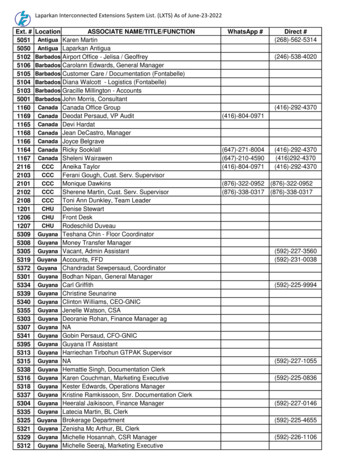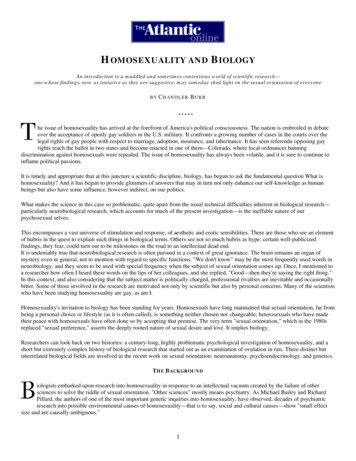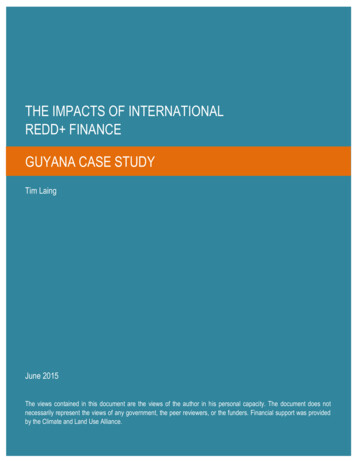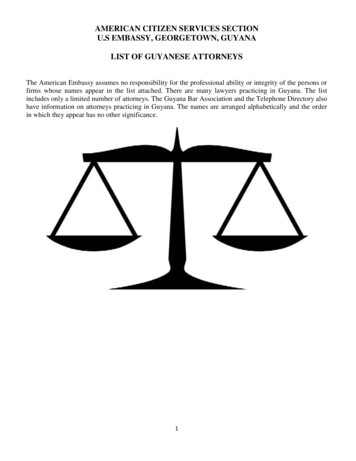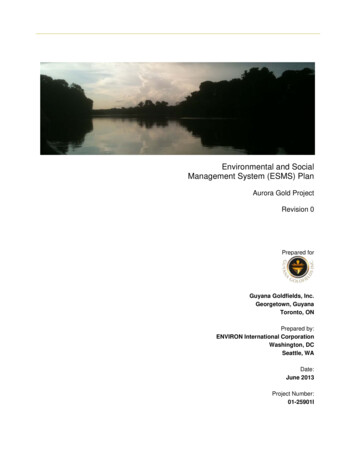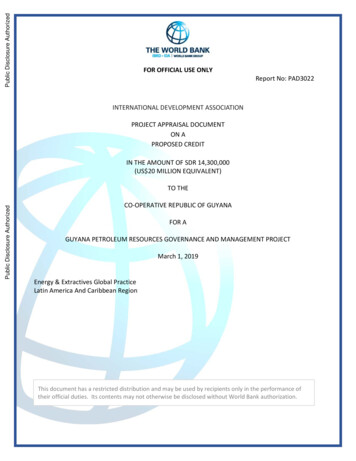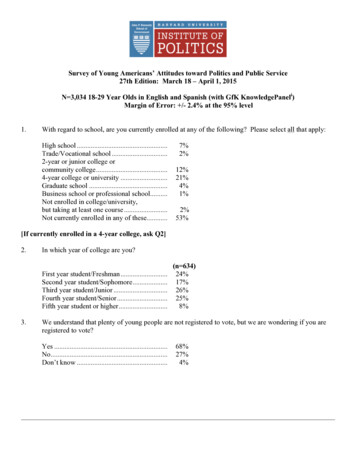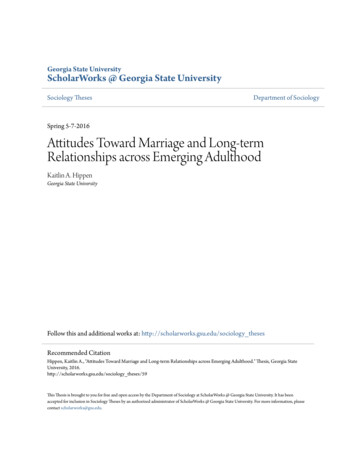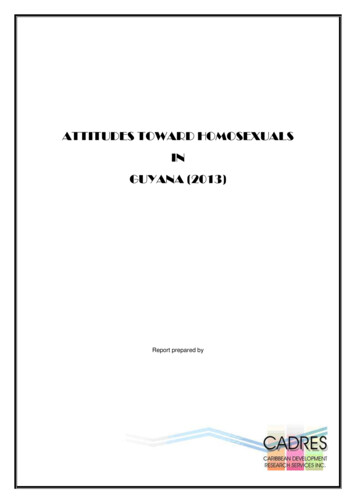
Transcription
ATTITUDES TOWARD HOMOSEXUALSINGUYANA (2013)Report prepared by
CONTENTSSYNOPSIS . 4ACKNOWLEDGEMENTS . 6INTRODUCTION, METHODOLOGY AND LIMITATIONS . 8Table 01: . 8Region of Interview . 8SURVEY DEMOGRAPHICS . 11Table 02: Sex of Respondent . 11Table 03: Race of Respondent . 11Table 04: Age Range of Respondent . 11Table 05: Respondent’s Origin. 11Table 06: Respondent’s Income Range . 12Table 07: Respondent’s Status . 12Table 08: Respondent’s Employment Status. 12Table 09: Respondent’s Quantity of Children . 12Table 10: Respondent’s Highest Level of Schooling . 12Table 11: Religious Orientation . 14ATTITUDE TOWARD HOMOSEXUALS . 16Table 12: Scale of Acceptability . 18UNDERSTANDING OF HOMOSEXUALITY . 20Table 13: Preferred “remedy” for Homosexuality . 22Table 14: Most important source in the formation of views and opinions on HumanSexuality . 22Table 15: Schools should teach children scientific facts about Homosexuality as part ofsex and sexuality education? . 23ATTITUDE TOWARDS DISCRIMINATION/VIOLENCE AGAINST SEXUAL MINORITIES. 24ATTITUDE TOWARDS LEGISLATION . 28Table 16: Views and opinions on existing Laws . 30Table 17: Moral and Practical Priorities . 36COMPARATIVE GUYANESE ATTITUDES . 37APPENDICES . 40Appendix I: Survey Instrument . 40Appendix II: Location of Interviews . 48Attitudes toward Homosexuals in GuyanaPage 2 of 50
Figure 1: Sexual Orientation (Declared). 13Figure 2: Religious Persuasion . 14Figure 3: Gay Associations . 15Figure 4: General Attitudes Toward homosexuals. 16Figure 5: Impact of Religion on Attitude . 17Figure 6: Impact of Association with Homosexuals . 18Figure 7: Response to Homosexual Awareness . 19Figure 8: Meaning of the word "Homosexual" . 20Figure 9: Origin of Homosexuality . 21Figure 10: Is Homosexuality an "Illness" that can be cured? . 21Figure 11: Violence against Gays or Sexual Minorities "IS" Discrimination . 24Figure 12: "Homophobia" can contribute to. . 25Figure 13: Acceptable to treat people differently (Discriminate) on the basis of. . 26Figure 14: The State needs to provide special protection from discrimination to. . 27Figure 15: General Support for the Guyana "Buggery" Law . 28Figure 16: Should Homosexual Acts between Consenting Adults be Legal/Illegal (USA 1977-2010) . 29Figure 17: Rationale for Buggery Laws. 32Figure 18: "Common Law" Marriage versus "Same Sex" Marriage . 32Figure 19: Gay Rights Issues . 33Figure 20: Possible Reasons for Changing Laws. 34Figure 21: The Guyanese State SHOULD penalise . 35Figure 22: Legislative Preferences . 36Figure 23: Comparative Issues . 38Figure 24: Would change Party Support based on Gay Stance . 39Attitudes toward Homosexuals in GuyanaPage 3 of 50
SYNOPSISGenerally this survey demonstrates that Guyanese are largely either tolerant or accepting ofhomosexuals, with the quantity of persons that could genuinely be described as “homophobic”amounting to approximately 25% of the population. Conversely this means that 58% of Guyanese areeither “tolerant” or “accepting” of homosexuals, while 17% were undecided. It is also immediatelynoticeable that homophobia or alternatively tolerance of homosexuals correlates directly with age,sex, race and to a lesser extent religion, place of origin and education. As such, women, youngerpersons and Guyanese who were not born in Guyana tended to be more comfortable withhomosexuals, while active-Evangelical Christians, Afro Guyanese and those who have been “lesswell” educated tended to be more homophobic.Notwithstanding the largely positive stance of the vast majority of Guyanese towardhomosexuals, it is also clear that fundamental misunderstandings exist among Guyanese regardingseveral basis facts about homosexuality and it is entirely possible that these misunderstandings couldimpact negatively on attitudes. Guyanese generally think that homosexuality is largely a malephenomenon and moreover that it is a “choice”. These are two misunderstandings that carrysubstantial baggage. There is also a heavy religious overtone regarding the “proper” location ofsexual orientation and sexual expression, along with the presumption that the religious teachingshould continue to influence the State’s agenda and treatment of homosexuals.With regard to discrimination (as manifested in violence) the survey demonstrates clearly thatGuyanese do dislike the idea of violence against minorities and discrimination in all its manifestations.Moreover, Guyanese largely consider discrimination against homosexuals to be “wrong”. At the sametime; however Guyanese do not seem to think that homosexuals are currently being discriminatedagainst, or that the state needs to provide special protection for them. Interestingly, there is strongsupport for the provision of special protections for Persons Living with AIDS (PLWA) and while someof these persons might be homosexual, there is no strong desire on the part of the population forspecific protections for homosexuals against discrimination.The general Guyanese reaction to the legislative environment that relates to homosexuals isto say the least, conflicting. A slender majority of Guyanese support the retention of the “buggerylaw”; however further investigation reveals that many of these persons are both unfamiliar with thespecific provisions of this law and when advised of the specifics believe it to be “illogical” in someinstances. Notwithstanding there is a clear resistance on the part of the population to “let go” of theselaws which a majority of persons believe are a clear expression of Guyana’s moral and religiousstandards. In this regard, it is interesting to note the populations’ ability to separate religion and stateas it relates to the propriety of “Common Law” marriage, while the state is presumed to have anobligation to project religious principles as it relates to homosexual acts.Although there is no profound appetite for legislative change at this time, Guyanese believethat a clear demonstration that these laws are impacting negatively on the physical or psychologicalwell-being of young people or adults would provide good grounds for change. There is also supportfor change if it can be proven that the laws contribute to the spread of HIV/AIDS. It should be madeclear; however that in neither instance has the survey demonstrated that Guyanese are convincedthat either of these “perils” have manifested themselves locally on account of the existence of buggerylaws.Attitudes toward Homosexuals in GuyanaPage 4 of 50
The actually stated legislative preferences of Guyanese at this time are noteworthy sincethese speak to the activities that Guyanese wish to prevent. In this regard it is clear that Guyanesedesire most to prevent “public sex” of any sort, but are especially concerned about relations betweentwo or three men. Although there is a stated preference for the retention of the buggery law, there islittle interest in having the state prevent private sex between adults (of any sex) if that were possible.This peculiarity suggests that Guyanese are perhaps really concerned about public manifestations ofsexual orientation, as distinct from private manifestations and appear to believe that the changing ofthe laws would help to encourage these public manifestations.The juxtaposition of Guyanese support for decriminalisation (of homosexual acts) with theiropinion on other major social issues does lend support to the suggestion that Guyanese are lesscommitted to the retention of these laws than they are to issues like corporal punishment which alsohave a religious justification. This distance is significant, as is the finding in the survey that theposition of a political party is not likely to affect its chances at the polls.Attitudes toward Homosexuals in GuyanaPage 5 of 50
ACKNOWLEDGEMENTSThis research was funded entirely by a research grant from the UK Foreign andCommonwealth Office (FCO). The FCO’s support for this project and interest in the broader subjectmatter as an aspect of Caribbean development is acknowledged with gratitude. Needless to say, thesubstance of this research was in no way influenced by the FCO and would in no way reflect theFCO’s views or opinions. CADRES and SASOD as the primary partners are grateful to the FCO forndtheir assistance and the interest shown in this project by FCO 2 Secretary (at that time) Mr DanielCarruthers who provided the necessary guidance to enable the navigation of the FCO’s administrativerequirements.This project was initially conceptualised by CADRES which executed a 2004 study onBarbados that was similar. Mr Joel Simpson of SASOD became aware of this study and quicklyexpressed an interest in having it replicated in Guyana. His personal interest in this work andcontribution to initial negotiations to identify funding is therefore noted, as distinct from anycontribution that was later made by SASOD as an organisation. Similarly, the essential contribution ofSASOD member Mr Jermaine Grant is noted since his individual contribution both to the developmentof the instrument and his management of the data collection and tabulation exercises wereindispensable.Although this study was loosely based on a similar 2004 Barbados study, this presentexercise represents a substantially improved research product which benefited from a considerablyexpanded research instrument that spoke to several issues that were contingent to and impacted onthe Guyanese attitude toward homosexuals. CADRES is grateful to the team of professionals whofreely gave of their time to participate in the design of a comprehensive regional survey instrumentand later commented on various drafts of this report. The specific names of persons who participatedin the various aspects of the report are specifically identified here (in no particular order) with thanks:Initial Project Seminar (Port of Spain, Trinidad)Peter W. Wickham, CADRESKristen C. Hinds, CADRESJermaine Grant, SASODTamara Sylvester, CAISOColin Robinson, CAISOBrendon O'Brien, CAISOSheldon L. Daniel, SXD CommunicationJohn Hassell, UN AIDSDesign and Refinement of Survey InstrumentPeter W. Wickham, CADRESKristen C. Hinds, CADRESJermaine Grant, SASODJoel Simpson, SASODZenita Nicholson, SASODTamara Sylvester, CAISOColin Robinson, CAISONadine Lewis-Agard, CAISOArif Bulkan, UWIAlana Griffith, UWIJaneille Matthews, UWITracy Robinson, UWISheldon L. Daniel, SXD CommunicationJohn Hassell, UN AIDSData Collection and TabulationJermaine Grant, SASOD: Survey Team LeaderAttitudes toward Homosexuals in GuyanaPage 6 of 50
BACKGROUNDThis study is a seminal exploration of the Guyanese attitude toward homosexuals fromdifferent perspectives, but is also an individual component of a three-country research project thatsought to collect similar data in Trinidad and Tobago and Barbados. A similar study was first done byCADRES in Barbados in 2004; however this was based on a small number of questions that werepart of an omnibus UWI/CADRES study. In August of 2010 CADRES responded to an invitation fromthe Society Against Sexual Orientation Discrimination (SASOD) to present the Barbados findings toan OAS/LGBT Workshop on Human Rights in Georgetown and at this meeting discussions wereinitiated to implement this 2013 study and expand the number of countries involved.Having secured funding from the UK FCO for the execution of two identical studies in Guyanaand Trinidad and Tobago and from the Barbados HIV/AIDS Commission for a similar Barbados study,CADRES solicited the assistance of a regional team that represented all relevant interests. Initiallyelectronic contact was established with representatives from SASOD in Guyana, Trinidad andTobago’s Coalition Advocating for Inclusion of Sexual Orientation (CAISO) and The United Gays &Lesbians Against AIDS Barbados (UGLAAB) in Barbados as well as academics from UWI with aninterest in this issue. Thereafter a meeting was convened in Port of Spain with the principalresearchers, which reflected on the 2004 study and identified specific research issues and receivedsuggested questions which were later refined electronically.A single generic instrument was agreed upon in March of 2013 and deployed in all threeterritories around the same time; however it was agreed that it was unwise to rely on a research teamthat was exclusively drawn from any of the three LGBTQI organisations since that would havepresented a clear bias. Instead the partners agreed to the identification of country specific managersthat were known to CADRES, who would in-turn recruit an independent team to collect and tabulatedata in each instance.The report that follows represents what could be considered a comprehensive presentation ofdata; however it was agreed that this report should not be seen or used as a strategic document.Instead SASOD and other partners would be expected to draw information from it to either informtheir advocacy or to make pronouncements on specific aspects of any issue spoken to. Thedocument is large, technical and perhaps presents too much data to be placed in the public domain,but should instead remain a resource for persons or groups interested in these issues.Attitudes toward Homosexuals in GuyanaPage 7 of 50
INTRODUCTION, METHODOLOGY AND LIMITATIONSThe survey employed a stratified random sample of Guyana which identified as primary strata: Age; andGender;In addition, other demographic information was solicited and collated; however the survey was notdesigned to replicate these characteristics in a manner that was proportionate to the population ofGuyana.Data that are presented in these instances would therefore bear some relation to thenational scenario, but would not be a conclusive indicator of the extent to which that variable ispresent in the population of Guyana.Interviewers were each assigned areas based on a random selection normally associated withPolling Divisions (PDs) in each administrative division.PDs are almost equal subdivisions ofAdministrative Divisions which are normally used for electoral purposes. In this instance; however thefact that PDs are numbered allowing for a random selection of specific divisions which were thenroughly translated into geographical districts or zones.In each instance, interviewers selected 12, 24, 36 or 48 households in a random manner (one inthree) and conducted one face to face interview at each of 12, 24, 36 or 48 households. Interviewerswere specifically advised not to conduct interviews in public areas like bars, or among groups sincethe intention was to replicate national views and opinions based on a standard geographicaldistribution within households. The proportion of persons interviewed from each of Guyana’s 10Administrative Divisions is presented in Table 01 and Appendix II presents comprehensiveinformation on the areas or districts in which interviews were conducted and the actual number ofinterviews conducted in each instance.Table 01:Region of InterviewAttitudes toward Homosexuals in Guyana14%211%317%436%57%614%73%83%93%104%Page 8 of 50
The survey was largely interviewer administered; however interviewers were instructed toyield to the respondent’s preference to complete the survey form themselves if such a request wasmade.There was also a section that was set aside for self-administration since it exploredconfidential issues. In that instance, the reverse instruction was given to interviewers who wereadvised to complete these forms for the respondent if such a request were made.The analysis that follows arises from these cases which were 1,034 in total and the specificquestionnaire that was administered is presented in Appendix I. This survey was developed by aregional team that included representatives from SASOD, CAISO, and UGLAAB, and submissionswere entertained from all three of these organisations with respect to the areas of interest at ameeting in Trinidad during October of 2012. The extent to which this process was “regionalised” wasdeliberate since the partners were all regional organisations responsible for LGBTQI issues andtherefore had similar concerns. Since the legislative environment is similar and cultural environmentsalso roughly similar, it was considered prudent to take a similar approach which would ultimately alsoallow for regional comparisons.The initial survey planning meeting was held in Trinidad and Tobago (October 2012) and theteam agreed on the broad issues that the survey would cover. Thereafter two-drafts were circulatedto concerned parties for comment and revision and thereafter the final survey instrument was agreedupon, printed and deployed in the respective countries. The design team agreed on broad guidelinesfor the conduct of the exercise and among them was the critical agreement that the survey should beexecuted by interviewers who were perhaps not “obviously gay” or at least not exclusively confined tomembers of the LGBTQI Association in any of the countries involved.It was agreed that thisarrangement would enhance the credibility of the research exercise.The analysis that follows speaks largely to national conclusions; however in select instancescomparative data has been presented which demonstrates the impact of demographic characteristicssuch as age, gender or religion which appear to influence the opinion being presented. In scientificterms these associations are known as correlations and throughout the report any instance in whichsuch an “influence” or “impact” is mentioned, it can be assumed that the correlation referred to iswithin a /- 5% margin of error which means that CADRES is 95% confident that such a correlationexists and is not accidental.The 95% measure is generally considered satisfactory within thescientific community and the tool of measurement used is the “Chi Square” test. In all instanceswhere a demographic association is mentioned it can be assumed that the “Chi Square” test has beenapplied, but in no instance is the test statistic presented since the audience for this report is generallynot a scientific one. In instances where mention is made of a statistically insignificant association thiswould mean that the measurement of such an association has fallen below the 95% confidence level.Attitudes toward Homosexuals in GuyanaPage 9 of 50
This study is seminal in the case of Guyana and there has only been one previous study doneregionally (Barbados 2004). As such the study’s main limitation is the fact that it provides a staticmeasurement of attitude and opinion and cannot speak to evolving attitudes in the Guyanese context.The data is likely to be useful nonetheless since it can speak to contemporary views and opinions onthe issue.This study was conceptualised by CADRES and sought to build on a similar studyconducted in Barbados (2004). That study was limited since it was part of a larger omnibus survey,while this one is specialised and focused exclusively on the respondent’s opinion of homosexuals,homosexuality and attendant issues. This specialised focus is therefore advantageous and it is alsofortunate that this study was able to address several of the deficiencies of the 2004 study.In this instance; however, some respondents complained about the length of the survey andthe occasional complex nature of it. Several of the issues explored were technical and legal andalthough an effort was made to simplify the questions, there were instances in which the respondentdid not understand what was being asked. In the case of Guyana there was one question which isidentified specifically which was clearly not understood by a substantial quantity of respondents andas such could not be used in the analysis.Another concern identified in the course of interviewing relates to the demographic categoriesused which failed to identify “Amerindians”. Such persons interviewed were therefore categorized as“Mixed” and “Others”. Those that were identified as “Mixed” preferred to be referred to as suchinstead of being called “Others.” In the case of religion, many Hindus in Guyana are apparently alsoChristians and there was no option for a person to select both options. In both instances, the quantityof people affected would appear to be small and would not affect the reliability of the survey.Attitudes toward Homosexuals in GuyanaPage 10 of 50
SURVEY DEMOGRAPHICSIn this section data are presented largely for purposes of information as these demographiccategories are used later in the analysis to determine the extent to which relationships exist betweenthe different variables. Tables 02 through 11 and related charts speak to a range of demographicswhich are standard in surveys of this nature. It was intended that the “Age” and “Sex” categoriesshould be almost similar to the national demographic spread; however it appears as though thissurvey slightly over-represented young people at the expense of older people interviewed. This skewis perhaps a result of the fact that older people would have had less interest this subject matter andwould therefore have been unwilling to respond to an interview this challenging. Such “biases” arenot avoidable and would not impact negatively on the reliability of the survey exercise.Table 02: Sex of RespondentTable 03: Race of RespondentMale47%Afro (Black)Female53%Anglo (White)1%Sino (Chinese)1%Indo (East Indian)Portuguese37%26%5%Mixed26%Other4%The issue of race is of particular importance in Guyana and it would appear as though theinterviewers captured a slightly higher proportion of Afro Guyanese, which is no doubt related to theareas that interviews were conducted. It should be stressed; however that the survey was NOTdesigned to match the national racial distribution and moreover the selection of areas andrespondents was random and no special attempt was made to identify respondents based on theirrace, but instead interviewers identified respondents and thereafter sought information about theperson’s racial classification.Table 04: Age Range of Respondent18-30 Years42%31-50 Years34%51 and over24%Attitudes toward Homosexuals in GuyanaTable 05: Respondent’s OriginYes, Native Born90%Not native born8%Prefer not to say2%Page 11 of 50
In the case of income, CADRES is often sceptical of the information given, especially as closeto one-quarter of respondents did not provide this information which limits its utility.Table 06: Respondent’s Income RangeLess than 20,0008% 20,000 - 40,00018% 40,000 - 60,00019% 60,000 - 80,00012% 80,000 - 100,00011%Over 100,0009%Won't say24%Table 07: Respondent’s StatusSingle39%Married34%Married (Common Law)11%Divorced4%Separated6%Widowed3%Won't Say3%Table 08: Respondent’s Employment StatusEmployed (Full-time)52%Employed tudent6%Retired4%Self Employed16%Other/Won't say4%Table 09: Respondent’s Quantity of 110.2%120.1%130.1%160.2%Table 10: Respondent’s Highest Level of hnical/Vocational10%Tertiary31%Attitudes toward Homosexuals in GuyanaPage 12 of 50
Since the survey inquired privately into the respondent’s sexual orientation, an assessment ofthe overall “Sexual Profile” of Guyana is presented in Figure 01 as part of the demographicassessment.Although this information was tabulated based on a self-admission that wasconfidentially collected, CADRES remains sceptical of this type of information because the issue ofsexuality is still very sensitive in Guyana and homosexual acts are still illegal there. As such cautionis recommended on the side of admitted heterosexuality, since homosexuals will be less likely toadmit to being this way inclined.There have been very few studies that have attempted to scientifically estimate the quantity ofhomosexuals resident in any country; however global estimates generally fall within the 1-10assumption which would translate to a presumed 10% of any population being homosexual.In thisinstance 3% have admitted to being homosexual (male or female) in Guyana with 4% admitting to bisexuality. It is most interesting; however that 15% of persons indicated that they were unwilling toanswer this question and if we assume that a heterosexual would have no difficulty stating this, thepresumption is that an additional 15% of respondents could easily be homosexual or bisexual whichcould make Guyana’s resident population of homosexuals and bisexuals relatively “high” in theespecially if we consider global estimates. The most generous assessment of these data would implysomewhere in the vicinity of 20% of Guyanese being either homosexual or bisexual.Sexual Orientation 2%3%2%OtherMixedAfro (Black)PortugueseFemaleIndo (East Indian)MaleSino (Chinese)51 and overSexAnglo (White)31-50 Years18-30 YearsAgeI prefer not to erosexualRaceAllGuyanaFigure 1: Sexual Orientation (Declared)The issue of religious persuasion was also isolated in the demographic discussion largelybecause it is both complex and proven in the study to be one of the main “drivers” of homophobia. Inthis instance respondents were asked to select a Religious category and thereafter
Attitudes toward Homosexuals in Guyana Page 6 of 50 ACKNOWLEDGEMENTS This research was funded entirely by a research grant from the UK Foreign and
